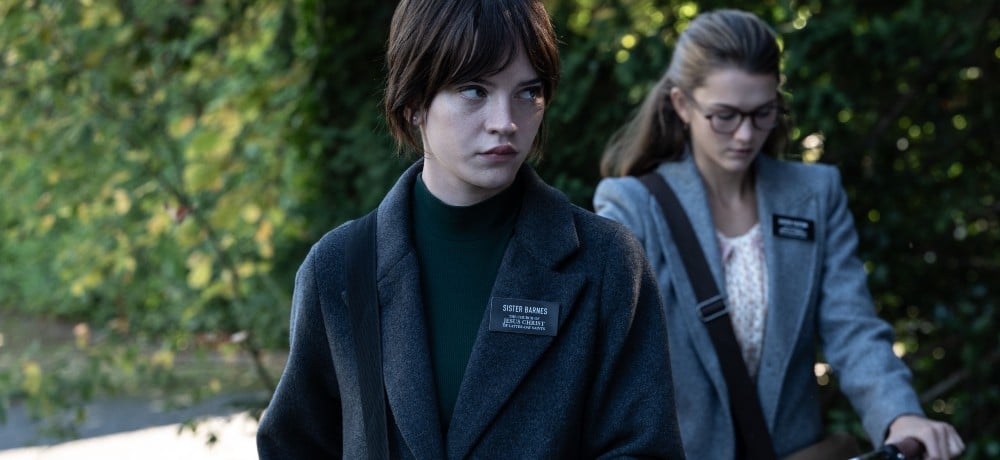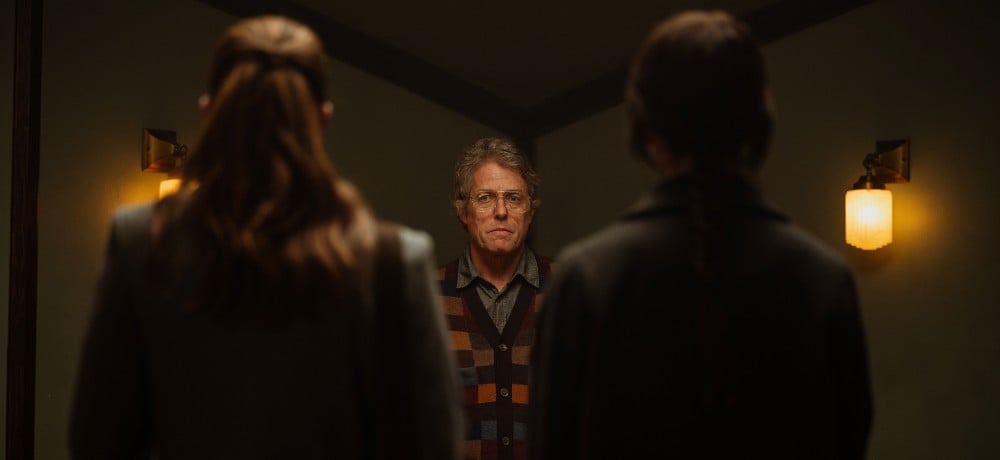


[Editor's Note: This article discusses Heretic in detail, including spoilers.]
The primal fear of the human body itself—not ghosts, not demonic presences—haunted me after watching Heretic (2024). Body horror, with its grotesque parade of morphing flesh, decomposition, and unnatural transformation, holds up a visceral mirror to remind us: metamorphosis is terrifying because it’s uncannily relatable. Horror doesn’t just lurk in the shadows; it festers, blooms, and erupts from within.
This feels like the perfect time to bring in “The Abject,” a term Julia Kristeva introduced in Powers of Horror (1980). Kristeva describes it as “the human reaction (horror, vomit) to a threatened breakdown in meaning caused by the loss of the distinction between subject and object or between self and other.” A high-concept idea, sure, but let’s make it simple: imagine peeling an apple and finding human flesh beneath the skin. That gut-churning unease? That’s The Abject! The moment when the boundaries between YOU and what’s inside you start to dissolve. Now, ramp up the discomfort: what if what’s inside is itself monstrous?
And this is where things get really interesting (and deeply unsettling). Let’s talk about women’s bodies. Historically shrouded in mystery, even today, with all our medical advancements and cutting-edge research, there’s so much we don’t fully understand about them. And what we don’t understand? Well, we fear. Fear, after all, is often just ignorance dressed up in anxiety.
Mary Russo calls this the “Deep Damp Invisibility” of women’s reproductive organs, a phrase that sounds like something pulled from a gothic novel but perfectly captures how much about female biology remains obscured or willfully ignored. But there’s another layer: women’s bodies, in all their fluidity, messiness, and perceived unpredictability, have long represented everything patriarchal structures seek to control: pain, vulnerability and transformation. And yet, paradoxically, these same qualities provoke fear. Why? Because they challenge the neat, sterile categories society loves to impose: strength vs. weakness, self vs. other, subject vs. object. In short, women’s bodies are The Abject. And nothing is more terrifying than what refuses to be neatly defined.
So, when we return to Heretic, we’re not just witnessing body horror as spectacle; we’re confronting deep-seated cultural anxieties about bodies, especially the ones we’re most afraid to understand. Horror, after all, has always been a language for what we dare not say aloud. And with Heretic, it doesn’t just whisper—it screams.
In Heretic (2024), women don’t simply suffer; they decompose, transform, and mutate into something terrifyingly other. Their bodies, stripped of autonomy, caged, and left to rot, aren’t just grotesque for the sake of horror aesthetics. They’re walking (or, more accurately, collapsing) embodiments of deeper fears, carrying centuries of patriarchal baggage. The film stitches Catholicism and horror together seamlessly, exposing the real “one true religion” at play: fear. And, really, isn’t that the most fitting pairing? Religion has long been obsessed with purging what Julia Kristeva calls The Abject—that messy, liminal space where boundaries blur between self and other, sacred and profane, human and monster.
Take, for instance, the moment a supposed “prophet of God” is about to be resurrected. Her decayed body, a crumbling relic of faith, is paraded as both divine spectacle and grotesque warning. The ritual meant to restore her holiness only amplifies the horror of her flesh: fragile, rotting, undeniably human. And that’s the real terror, isn’t it? That no amount of divine intervention can save us from the decay written into our biology. Heretic forces us to sit in that discomfort, making us watch as faith collides head-first with the inevitability of the body’s breakdown.
But Heretic doesn’t just show us body horror; it makes us question why it unsettles us in the first place. Women’s bodies have always been cinematic battlegrounds, wielded to evoke lust, fear, and disgust, sometimes all at once. Here, the film turns that tradition on its head, challenging why deviations from the so-called “normal” female body provoke such visceral reactions. The horror isn’t just in the transformations; it’s in the deeply ingrained anxieties that make those transformations feel monstrous to begin with.
Nowhere is this more harrowing than in Heretic’s final act, where women—caged like animals, starved of food and water—are left to decompose, with their bodies hollowing into skeletal husks. It’s a scene that unsettles not just for its grotesque visuals but for what it represents: the absolute annihilation of autonomy, the perversion of faith into a weapon, and the brutal reality of bodies reduced to mere suffering vessels. The image of rotting, imprisoned women is a bleak metaphor for how patriarchal structures determine the worth of women’s bodies: controlling them until they are deemed “useless” and discarding them without a second thought. It taps into age-old anxieties around female aging and desirability, where women who no longer serve reproductive or sexual functions are systematically erased, ignored, or vilified.
But, Heretic doesn’t stop at simple bodily horror, it warps the very act of looking. In a dark twist on traditional scopophilia, the film forces its imprisoned women to become both the objects of horror and its unwilling spectators. Trapped together, they are condemned to watch one another decay, each woman’s suffering mirrored back at her in the bodies of those around her. Horror cinema typically positions women under the male gaze, but, here, the gaze is inescapable, internalized, and weaponized. They are stripped of privacy, agency, and even the small mercy of looking away, transforming into living omens of their own fate. This forced voyeurism deepens the psychological horror, ensuring that suffering is not only endured, but witnessed in real time.

This stands in stark contrast to how male transformations are often framed in body horror. Films like The Fly (1986) or Tetsuo: The Iron Man (1989) present grotesque bodily mutations, but, for men, these changes frequently come with power: intellectual, mechanical, supernatural. Even when tragic, their transformations carry an undercurrent of agency or evolution. Women’s transformations, on the other hand, tend to signify degradation, punishment, and the loss of control, whether it’s The Brood (1979), Carrie (1976), or Contracted (2013). Their bodies become monstrous, not as a means of transcendence, but as a form of suffering, moral reckoning, or social condemnation, reinforcing long-held patriarchal fears of female autonomy.
By rejecting the idea of bodily transformation as empowerment, Heretic lays bare the gendered horror of the flesh. It forces us to confront the uncomfortable truth: women’s bodies are often only valued when they conform to specific, societally-approved standards, whether of youth, beauty, or function. The moment they deviate, they cease to be seen as human at all, transforming into something monstrous, disposable, and abject. But Heretic doesn’t just exploit this fear, it holds a mirror to it, making us stare directly into the cultural anxieties that have shaped it.
Why does this trope keep resurfacing? Simple: it forces us to confront the big, ugly questions- who controls women’s bodies? How are they viewed? As sacred vessels of life? Symbols of purity? Or something monstrous when they break the mold? And when these anxieties fester, where do they leak out? Right into our media. Heretic seizes this unease and filters it through the lens of Catholicism, where the tension between the divine and the corporeal is as old as the doctrine itself.
Julia Kristeva’s concept of the abject, the liminal horror that exists between self and other, comes in handy here. The abject is that which was once part of us, but is now expelled, something that triggers both disgust and fear. It’s why bodily fluids, decay, and transformation make us recoil. And if there’s one thing horror loves, it’s the abject. Women’s bodies, in particular, have long been framed this way: too unpredictable, too leaky, too tied to the terrifying mysteries of reproduction. Religions, especially those with strict purity doctrines, have spent centuries trying to contain, cleanse, or outright reject this messiness. Catholicism, with its obsession with sin and sanctity, is the perfect playground for such fears. Heretic doesn’t just revel in body horror, it interrogates why we have historically revered and reviled the female body in equal measure.
But at its core, Heretic is a film about transformation, of bodies, of identities, of faith itself. Change is unsettling because it reminds us of life’s fundamental instability. By presenting bodily horror not just as a grotesque spectacle but as a meditation on mutation and decay, the film forces us to ask: why does transformation frighten us so much? Heretic doesn’t just want to scare you, it wants to make you sit with the discomfort of that question. And maybe, just maybe, realize that the horror isn’t just in the flesh, but in what we project onto it.
Body horror has always occupied a fascinating, uneasy space within feminist horror studies, especially when it comes to how it disrupts the ‘male gaze’ as defined by Laura Mulvey. Traditionally, women’s bodies in horror films exist at two extremes: hypersexualized objects of desire or grotesque sites of punishment. Heretic refuses to play by those rules. Instead, it weaponizes expectation, rejecting the cinematic norms that render female suffering as either erotic spectacle or empty shock. The film doesn’t just present the female body, it transforms it into something that terrifies, revolts, and resists.
At the heart of Heretic is an interrogation of biological transitions—menstruation, childbirth, menopause—each a natural process, yet historically framed as something monstrous. These transformations have long been treated with suspicion, their visibility policed, their realities medicalized or outright vilified. Menstruation, for example, has frequently been depicted as a sign of corruption, an entry point into monstrous femininity (Carrie [1976] being the most famous example). Pregnancy, too, has long been a staple of body horror, often portrayed as a violation, an invasion of the body by something foreign, uncontrollable (Alien [1979], The Brood [1979], Inside [2007]). Heretic leans into these fears, but refuses to simply exploit them. Instead, it forces us to question why the womb itself is so often framed as horrifying, both in fiction and in broader cultural narratives.
And then there’s menopause, the final transformation, and one that horror has historically treated with a different kind of dread. Aging women are often rendered invisible; their bodies seen as unsettling, not just because they change, but because they lose their culturally ascribed ‘value.’ Heretic doesn’t sanitize this process or hide from it. It confronts the grotesque nature of bodily change head-on, daring its audience to look at what they’d rather ignore.
By doing so, Heretic doesn’t just join the lineage of horror films that challenge passive victimhood, it sharpens its teeth on it. It refuses to merely depict violence against women’s bodies; it turns the camera back on the viewer, demanding they confront why such violence has been normalized, even consumed as pleasure. The real horror, Heretic suggests, isn’t just what happens on screen—it’s the history of who’s been watching.